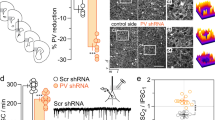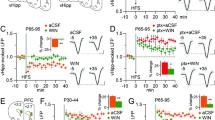Abstract
Objective
The prefrontal cortex (PFC) receives multiple cortical and subcortical afferents that regulate higher order cognitive functions, many of which emerge late in adolescence. However, it remains unclear how these afferents influence PFC processing, especially in light of the protracted, late adolescent maturation of prefrontal GABAergic function. Here we investigated the role of PFC GABAergic transmission in regulating plasticity elicited from the ventral hippocampus and basolateral amygdala, and how such modulation undergoes functional changes during adolescence in rats.
Methods
In vivo local field potential recordings, combined with prefrontal microinfusion of the GABA-A receptor antagonist picrotoxin, were employed to study the impact of ventral hippocampal and basolateral amygdala high-frequency stimulation on PFC plasticity.
Results
Ventral hippocampal-induced PFC plasticity begins to appear only by postnatal days (P) 45–55 with a transient suppression of the evoked response. A switch from transient to long-lasting depression (LTD) of the PFC response emerges after P55 and throughout adulthood (P65–120). Recordings conducted in the presence of picrotoxin revealed that PFC GABAergic transmission is critical for the expression of LTD. In contrast, basolateral amygdala stimulation resulted in PFC long-term potentiation, a form of plasticity that is already enabled by P30 and is insensitive to picrotoxin.
Conclusions
The development of ventral hippocampal-dependent PFC LTD is contingent upon the recruitment of local prefrontal GABAergic transmission during adolescence whereas plasticity elicited from the basolateral amygdala is not. Thus, different mechanisms contribute to the refinement of prefrontal plasticity during adolescence as inputs from these two regions are critical for shaping PFC functions.



Similar content being viewed by others
References
Abela AR, Dougherty SD, Fagen ED, Hill CJ, Chudasama Y (2012) Inhibitory control deficits in rats with ventral hippocampal lesions. Cereb Cortex 23:1396–1409
Andersen SL, Teicher MH (2008) Stress, sensitive periods and maturational events in adolescent depression. Trends Neurosci 31:183–191
Bacon SJ, Headlam AJ, Gabbott PL, Smith AD (1996) Amygdala input to medial prefrontal cortex (mPFC) in the rat: a light and electron microscope study. Brain Res 720:211–219
Bartos M, Elgueta C (2012) Functional characteristics of parvalbumin- and cholecystokinin-expressing basket cells. J Physiol 590:669–681
Benes FM (1989) Myelination of cortical–hippocampal relays during late adolescence. Schizophr Bull 15:585–593
Best JR, Miller PH (2010) A developmental perspective on executive function. Child Dev 81:1641–1660
Caballero A, Flores-Barrera E, Cass DK, Tseng KY (2013) Differential regulation of parvalbumin and calretinin interneurons in the prefrontal cortex during adolescence. Brain Struct Funct. doi:10.1007/s00429-013-0508-8
Carmichael ST, Price JL (1995) Limbic connections of the orbital and medial prefrontal cortex in macaque monkeys. J Comp Neurol 363:615–641
Carr DB, Sesack SR (1996) Hippocampal afferents to the rat prefrontal cortex: synaptic targets and relation to dopamine terminals. J Comp Neurol 369:1–15
Casey BJ, Giedd JN, Thomas KM (2000) Structural and functional brain development and its relation to cognitive development. Biol Psychol 54:241–257
Cass DK, Thomases DR, Caballero A, Tseng KY (2013) Developmental disruption of gamma-aminobutyric acid function in the medial prefrontal cortex by noncontingent cocaine exposure during early adolescence. Biol Psychiatry. doi:10.1016/j.biopsych.2013.02.021
Chambers RA, Krystal JH, Self DW (2001) A neurobiological basis for substance abuse comorbidity in schizophrenia. Biol Psychiatry 50:71–83
Chudasama Y, Doobay VM, Liu Y (2012) Hippocampal-prefrontal cortical circuit mediates inhibitory response control in the rat. J Neurosci 32:10915–10924
Cressman VL, Balaban J, Steinfeld S, Shemyakin A, Graham P, Parisot N, Moore H (2010) Prefrontal cortical inputs to the basal amygdala undergo pruning during late adolescence in the rat. J Comp Neurol 518:2693–2709
Cunningham MG, Bhattacharyya S, Benes FM (2002) Amygdalo-cortical sprouting continues into early adulthood: implications for the development of normal and abnormal function during adolescence. J Comp Neurol 453:116–130
Dan Y, Poo MM (2006) Spike timing-dependent plasticity: from synapse to perception. Physiol Rev 86:1033–1048
Davis M, Whalen PJ (2001) The amygdala: vigilance and emotion. Mol Psychiatry 6:13–34
Dilgen J, Tejeda HA, O’Donnell P (2013) Amygdala inputs drive feedforward inhibition in the medial prefrontal cortex. J Neurophysiol 110:221–229
Flores-Barrera E, Thomases DR, Heng LJ, Cass DK, Caballero A, Tseng KY (2013) Late adolescent expression of GluN2B transmission in the prefrontal cortex is input-specific and requires postsynaptic PKA and D1 dopamine receptor signaling. Biol Psychiatry (in press)
Floresco SB, Seamans JK, Phillips AG (1997) Selective roles for hippocampal, prefrontal cortical, and ventral striatal circuits in radial-arm maze tasks with or without a delay. J Neurosci 17:1880–1890
Gabbott P, Headlam A, Busby S (2002) Morphological evidence that CA1 hippocampal afferents monosynaptically innervate PV-containing neurons and NADPH-diaphorase reactive cells in the medial prefrontal cortex (Areas 25/32) of the rat. Brain Res 946:314–322
Gabbott PL, Dickie BG, Vaid RR, Headlam AJ, Bacon SJ (1997) Local-circuit neurones in the medial prefrontal cortex (areas 25, 32 and 24b) in the rat: morphology and quantitative distribution. J Comp Neurol 377:465–499
Garcia R, Vouimba RM, Baudry M, Thompson RF (1999) The amygdala modulates prefrontal cortex activity relative to conditioned fear. Nature 402:294–296
Gilmartin MR, Helmstetter FJ (2010) Trace and contextual fear conditioning require neural activity and NMDA receptor-dependent transmission in the medial prefrontal cortex. Learn Mem 17:289–296
Heng L, Beverley JA, Steiner H, Tseng KY (2011a) Differential developmental trajectories for CB1 cannabinoid receptor expression in limbic/associative and sensorimotor cortical areas. Synapse 65:278–286
Heng LJ, Markham JA, Hu XT, Tseng KY (2011b) Concurrent upregulation of postsynaptic L-type Ca(2+) channel function and protein kinase A signaling is required for the periadolescent facilitation of Ca(2+) plateau potentials and dopamine D1 receptor modulation in the prefrontal cortex. Neuropharmacology 60:953–962
Hoover WB, Vertes RP (2007) Anatomical analysis of afferent projections to the medial prefrontal cortex in the rat. Brain Struct Funct 212:149–179
Ishikawa A, Nakamura S (2003) Convergence and interaction of hippocampal and amygdalar projections within the prefrontal cortex in the rat. J Neurosci 23:9987–9995
Laroche S, Davis S, Jay TM (2000) Plasticity at hippocampal to prefrontal cortex synapses: dual roles in working memory and consolidation. Hippocampus 10:438–446
Maroun M, Richter-Levin G (2003) Exposure to acute stress blocks the induction of long-term potentiation of the amygdala-prefrontal cortex pathway in vivo. J Neurosci 23:4406–4409
Milad MR, Quirk GJ (2012) Fear extinction as a model for translational neuroscience: ten years of progress. Annu Rev Psychol 63:129–151
Morgan MA, LeDoux JE (1995) Differential contribution of dorsal and ventral medial prefrontal cortex to the acquisition and extinction of conditioned fear in rats. Behav Neurosci 109:681–688
O’Donnell P (2011) Adolescent onset of cortical disinhibition in schizophrenia: insights from animal models. Schizophr Bull 37:484–492
Paus T, Keshavan M, Giedd JN (2008) Why do many psychiatric disorders emerge during adolescence? Nat Rev Neurosci 9:947–957
Schumann CM, Bauman MD, Amaral DG (2011) Abnormal structure or function of the amygdala is a common component of neurodevelopmental disorders. Neuropsychologia 49:745–759
Seamans JK, Floresco SB, Phillips AG (1995) Functional differences between the prelimbic and anterior cingulate regions of the rat prefrontal cortex. Behav Neurosci 109:1063–1073
Spear LP (2009) Heightened stress responsivity and emotional reactivity during pubertal maturation: implications for psychopathology. Dev Psychopathol 21:87–97
Thomases DR, Cass DK, Tseng KY (2013) Periadolescent exposure to the NMDA receptor antagonist MK-801 impairs the functional maturation of local GABAergic circuits in the adult prefrontal cortex. J Neurosci 33:26–34
Tseng KY, Chambers RA, Lipska BK (2009) The neonatal ventral hippocampal lesion as a heuristic neurodevelopmental model of schizophrenia. Behav Brain Res 204:295–305
Tseng KY, O’Donnell P (2005) Post-pubertal emergence of prefrontal cortical up states induced by D1-NMDA co-activation. Cereb Cortex 15:49–57
Uhlhaas PJ, Singer W (2011) The development of neural synchrony and large-scale cortical networks during adolescence: relevance for the pathophysiology of schizophrenia and neurodevelopmental hypothesis. Schizophr Bull 37:514–523
Wang GW, Cai JX (2006) Disconnection of the hippocampal–prefrontal cortical circuits impairs spatial working memory performance in rats. Behav Brain Res 175:329–336
Acknowledgments
This research was supported by Rosalind Franklin University and the National Institutes of Health Grant R01-MH086507 to KYT. All experiments reported here comply with the current laws of the United States of America.
Conflict of interest
The authors have no conflicts of interest to disclose.
Author information
Authors and Affiliations
Corresponding author
Additional information
Adriana Caballero and Daniel R. Thomases are joint first authors.
Rights and permissions
About this article
Cite this article
Caballero, A., Thomases, D.R., Flores-Barrera, E. et al. Emergence of GABAergic-dependent regulation of input-specific plasticity in the adult rat prefrontal cortex during adolescence. Psychopharmacology 231, 1789–1796 (2014). https://doi.org/10.1007/s00213-013-3216-4
Received:
Accepted:
Published:
Issue Date:
DOI: https://doi.org/10.1007/s00213-013-3216-4




